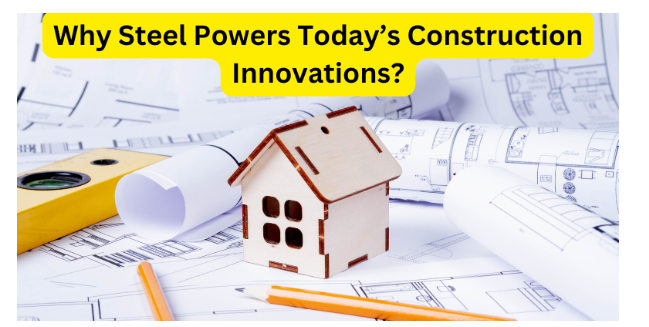Glenn Salamone Explains Why Steel Powers Today’s Construction Innovations

Steel is a key material in modern construction, acting as the foundation for many buildings and infrastructure projects. Glenn Salamone highlights Its incredible strength and durability make it perfect for structures like skyscrapers and bridges. As architects and engineers explore new design possibilities, steel provides the flexibility needed to build creative and lasting structures. In a world where safety and sustainability matter more than ever, steel continues to be a vital material. In this article, we’ll explore why steel is so important, covering its benefits for the environment, strength, adaptability, cost, and safety.
Steel Is Durable
According to Glenn Salamone, one of the most dependable and long-lasting materials used in contemporary construction is steel. It is the ideal material for big projects like skyscrapers and bridges because of its extraordinary strength, which enables it to support heavy loads.
One of steel’s main advantages is that it resists rust and severe weather, so buildings stay strong even in the most adverse conditions. Steel structures have a longer lifespan and require less maintenance over time due to their durability. This means lower overall costs and fewer repairs. Furthermore, steel’s longevity makes it a more environmentally friendly option, as it reduces the need for frequent replacements and promotes sustainable building practices.
Versatility in Design
Steel offers incredible versatility in architectural design, allowing for creativity and flexibility in construction. Architects and builders love using steel because it can be shaped and moulded into a variety of forms, from sleek modern designs to more intricate, artistic structures. Whether it’s creating curved roofs, expansive open spaces, or bold skyscrapers, steel makes innovative designs possible that might not be achievable with other materials.
Its strength also allows for thinner, lighter structures without sacrificing stability, giving designers the freedom to create larger windows, open floor plans, and unique shapes. This flexibility makes steel the go-to material for everything from high-rise buildings to sports arenas and bridges, offering both functionality and style in modern architecture.
Sustainability and Eco-Friendliness
Steel is an excellent material for environmentally friendly construction because it is not only strong but also very sustainable. One of its greatest benefits is that steel is 100% recyclable without sacrificing quality. As noted by Glenn Salamone, melting down old steel and reusing it in new projects significantly decreases the need for raw materials and reduces environmental impact. This commitment to recycling makes steel a vital component in promoting greener construction practices.
By using steel, builders can help to promote greener construction practices by producing less waste and consuming fewer resources. Furthermore, steel’s long lifespan reduces the amount of materials required for replacements or repairs, which lessens the impact on the environment. In modern projects focused on sustainability, steel plays a key role in reducing carbon footprints and promoting a more eco-conscious approach to building.
Speed and Efficiency in Construction
The use of prefabricated steel components greatly expedites the building process. The time spent on assembly is decreased because these parts are produced off-site and delivered to the building site ready for installation. This quick, efficient process allows projects to be completed faster than traditional methods.
In addition to saving time, steel is also cost-effective. Prefabrication minimises on-site labour, reducing costs associated with hiring large crews and extending work hours.
Steel’s durability and low maintenance needs further cut long-term costs, as structures built with steel require fewer repairs over time. Overall, the combination of faster construction and reduced labour and material costs makes steel an efficient and economical choice for both small and large-scale projects.
Applications in Different Types of Construction:
Steel plays a vital role in many types of construction projects, from massive skyscrapers to everyday homes. In large-scale commercial projects, like office buildings and bridges, steel’s strength and durability allow it to support heavy loads and withstand extreme conditions. Its ability to create strong yet flexible structures makes it ideal for designing complex and tall buildings.
In residential construction, steel is becoming increasingly popular. It’s used for framing homes, providing a sturdy foundation that resists termites, fire, and harsh weather.
Additionally, steel is very versatile, so it can be used for both big and small projects. Steel provides the adaptability and dependability required to create secure, long-lasting structures, whether it is being used to build a large shopping centre or a comfortable home. Its versatility keeps it at the top of builders’ lists for a variety of projects.
Looking Ahead: The Future of Steel in Infrastructure
Steel will become even more important in determining the future of infrastructure as building and design continue to advance. New technologies, such as 3D printing and high-strength steel alloys, are paving the way for stronger, lighter, and more sustainable structures.
Another exciting development is the integration of smart technology with steel buildings. For instance, structures could have sensors that monitor their own health and detect issues before they become serious. Additionally, adaptive infrastructure could respond to changing environmental conditions, making buildings safer and more efficient.
With these advancements, the future of steel in construction promises not only to enhance durability but also to improve overall efficiency and sustainability. As we innovate, steel remains a vital material that can help us build a smarter, more resilient world.
Final Destination
To sum up, steel provides unparalleled strength, durability, and versatility, making it a crucial component of contemporary construction. Glenn Salamone emphasises that it is a great option for a range of projects, from comfortable homes to tall skyscrapers, because of its capacity to support creative designs and sustainable practices. As technology develops further, steel will be essential to building environmentally responsible and effective infrastructure. Using steel in construction contributes to a more resilient and sustainable future in addition to improving safety.
